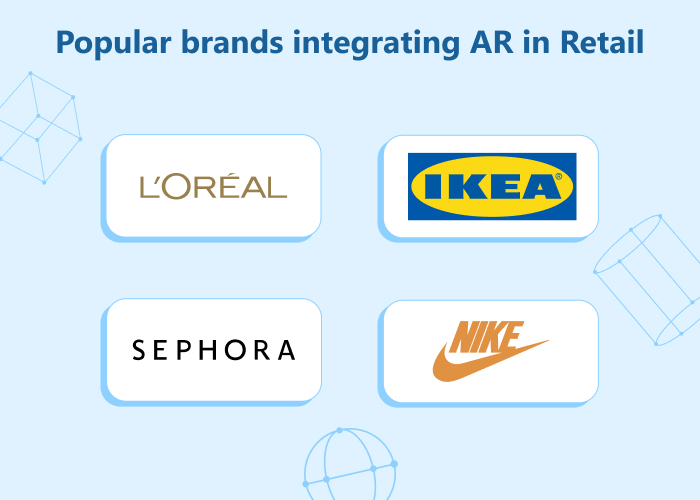Impact of Augmented Reality in Retail
AR in retail allows simplifying the procedures to make people’s buying (both online and offline) easier. The main advantages of augmented reality in retail shopping that customers frequently notice are listed below.
Ease in Try-on
The typical try-on experience has been completely transformed by augmented reality, especially in the fashion and cosmetics industries. Customers may virtually try on a variety of things in real-time, including cosmetics, apparel, and accessories.
This not only does away with the necessity for real fitting rooms, but it also gives customers the ability to digitally try things on before they buy, giving them greater confidence in their purchases. The outcome is a shopping experience that is more convenient and personalized while lowering the likelihood of customer discontent after a purchase.
Personalization
Content is frequently customized by retailers to exceed client expectations. Furthermore, online retail establishments have filters for you so you can find comparable products quickly. Virtual Reality (VR) technology is another tool used for improvement. Collectively, they provide all-inclusive AR/VR retail solutions.
Increased Customer Engagement
Retailers can build immersive ads, interactive campaigns, and eye-catching displays with augmented reality. AR not only draws attention but also improves brand visibility and creates a lasting bond between the customer and the brand by encouraging greater customer participation.
Seamless Online and Offline Integration
AR seamlessly connects physical and virtual retail channels. By simply scanning things with their smartphones, customers may utilize augmented reality (AR) applications in physical stores to obtain more product information, reviews, and promotions.
On the other hand, consumers who shop online may take advantage of virtual try-ons and interactive product encounters, resulting in a seamless shopping experience that goes beyond the constraints of conventional retail locations. Customers will find this connection more convenient, and shops will gain useful data regarding how customers behave across many touchpoints.
Popular brands integrating AR in Retail

Leading companies in the retail sector have gone through significant advancements by integrating AR. Brands have persuasively crafted augmented reality benefits for both online and offline purchasing to cater to consumers’ interests. Here are a few businesses that offer customer-focused AR apps that have made their reputations in the industry.
- L’Oreal: By introducing an AR makeup try-on feature, L’Oreal has revolutionized AR in retail use cases. Consumers may now test out the beauty products and visually evaluate various cosmetic looks on their faces.
- IKEA: IKEA is arguably the most recognizable business when it comes to furniture and electronics. Users find augmented reality quite useful as it lets them scan a specific piece of furniture with their phones and then superimpose it onto the image of their home. You may do it for your entrance, hallway, kitchen, restroom, bedroom, and so on.
- Sephora: Sephora has offered the Virtual Artist App, an augmented reality experience that lets consumers view how makeup looks on their faces through their phone’s camera. Additionally, users may learn which items or equipment to use with particular products.
- Nike: Nike uses VR and AR technology in their retail spaces. Customers may evaluate comprehensive product information by scanning products like clothes or shoes. Additionally, Nike provides its clients with an immersive virtual reality experience by letting them tour the many phases of the company’s supply chain, which openly communicates the origin and production process of each product.
Conclusion
The use of augmented reality in retail has sparked innovation to produce a more customized shopping experience. AR is changing the retail scene, giving customers more power and altering the relationship between businesses and their audiences with features like virtual try-ons and increased product presentation. Thus, the development of augmented reality in retail looks forward to more innovation in the next years, guaranteeing that shopping will always be exciting, and dynamic, and cater to the changing demands of customers.
FAQs
How does AR change the traditional try-on experience?
How does AR in retail bridge the gap between online and offline?
Can AR enhance personalized shopping experiences?
How does AR increase customer engagement in retail?
What is the future of Augmented Reality in retail?
Shivangi is a passionate Copywriter at Alian Software with expertise in technical copywriting. She shares information that is easy to understand regarding business, technology, and trends.